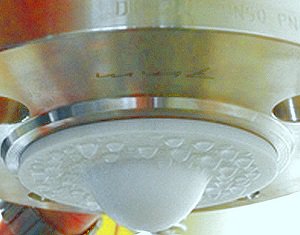Level measurement solutions: The impact of 80 GHz frequency
Dissolving Level Control Issues
At one of their major sugar beet refineries in the UK, British Sugar are at the forefront of innovation in level control. They have installed a new 80GHz radar from VEGA and put it through its paces on a very challenging application. At the first stage of production, the raw beet is first cut into strips and the sugar content diffused in hot water to form a liquor. This liquor is heated and boiled to concentrate it before being mixed with other process streams of varying densities in the ‘dissolver’ and level control of this process stage is where the new VEGAPULS 64 80GHz radar is deployed.
The dissolver consists of several interconnected agitated vessels, each one with a weir allowing the liquor to flow from vessel to vessel. During the dissolving process, sugar byproducts from the downstream refining process are also reintroduced to enable the sugars from those to be recovered and reused.
To ensure a continuous process, a reliable level measurement is required in the tanks, to control heat and product input as well as to maintain consistent output and quality. The liquid density is continually changing, the product is viscous and adhesive and slightly abrasive, so a direct level measurement with a non contact sensor is preferred.

Figure 1: Looking down the nozzle at the bubbling, foaming surface of the liquid. See video at bottom of page.
The sugar is heated typically at a temperature of 80-90 degrees, so the surface consists of a continuous ‘rolling’ surface foam (see fig), the tanks are vented to atmosphere and there is always heavy condensation present. For maximum vessel and process efficiency, the level runs close to the top of the dissolver. These conditions create many challenges for any contactless level transmitter, even radar based devices, with constant steam and heavy water droplets on the sensor itself. Originally a lower frequency device with 6” antenna was used to overcome the condensation and foam, but did not quite perform as required. With very high liquid levels in the vessel and foaming surface so close the radar antenna, it required regular cleaning of deposits to keep the unit functioning reliably.

Figure 2: VEGAPULS 64 radar with typical heavy condensation on sensor face from the dissolver process
When looking for test sites for the new 80GHz radar ‘Zero series’ sensors from VEGA, this was a perfect application task in a difficult environment. The sensor chosen was a unit with a DN150 fitting, to match the existing nozzle (although the size could be as little as 50-80mm with same performance). The unit was fitted by the end user and commissioned using a PLICSCOM plug in programmer, for in head set up of any VEGA plics® transmitter. The performance improvement was immediately apparent, providing continuous, accurate level data, no step changes and no sensor outages for cleaning.
VEGA engineers attended site shortly after and, with only very minor adjustments for testing and setting up the integrated sensor data logging for the trial, agreed the unit was working very well. The pilot data was monitored and retrieved and the successful unit remains now permanently installed and working well on site over 6 months later.
80 GHz contactless level radar - what and why is there a difference? The more directional, focused signal from 80 GHz technology versus the previous wider 26 GHz beam and wider-still 6.2 GHz radar, delivers more targeted energy to the product surface and receives more signal back. That capability must also be combined with some of the highest sensitivity electronics on the market and the smartest echo processing algorithms derived from almost 25 years of process radar supply. This package enables it to deliver excellent reliability in these challenging process conditions.
The customer is very happy with the unit and support from VEGA. They are now looking at several other applications where the unique capabilities of the 80GHz radar can be utilized in the sugar production process. Following successful pilots at 200 sites across the world, VEGAPULS 64 is now fully available with a build time of around 5 days. British Sugar engineers are also evaluating another interesting new innovation from VEGA, a new version of PLICSCOM programmer with Bluetooth, which enables set up and asset management via Smartphone or tablet of any VEGA transmitter.
Export this article
Download as PDFShare this article
Comments ({{comments.length}})
{{getCommentAuthor(comment, "Anonymous")}} {{comment.timestamp | date : "dd.MM.yyyy HH:mm" }}
{{comment.comment}}

